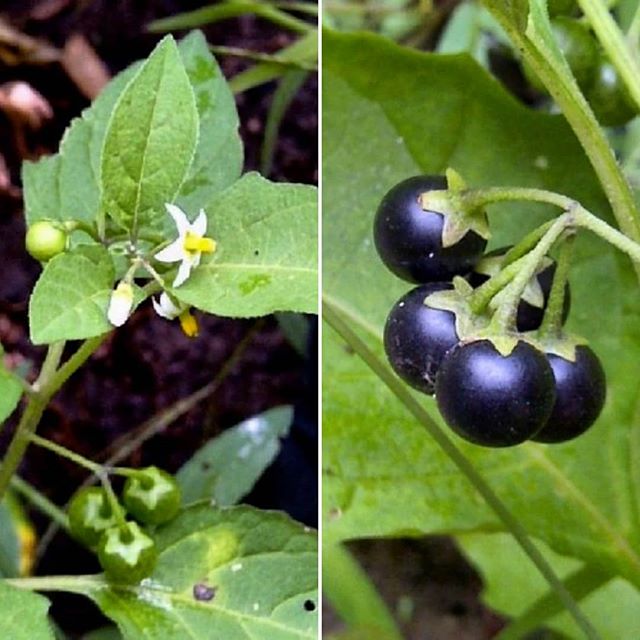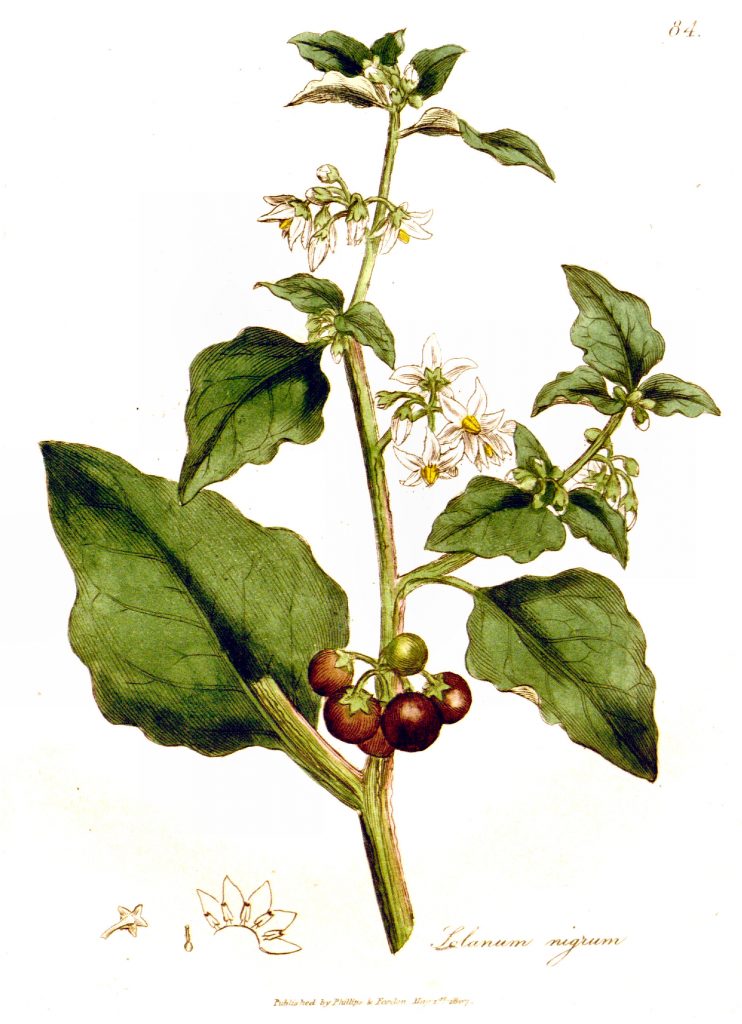Part of the family of witching plants that includes belladonna, datura, mandrake, and henbane, black nightshade is their humbler cousin. Commonly called garden nightshade, common nightshade or petty morel (for its similarity to belladonna—the great morel), Harold Roth of Alchemy Works has given this plant the nickname The Black Toad, and indeed it strikes us as being very toad-like.
Of a Saturnian, watery nature, black nightshade has qualities in common with other “toad plants”. It is a hedge plant, growing in waste places but still close to humans, occupying liminal spaces at the edges of fields and the bottom of the garden. Spreading foliage provides summer shade for garden toads, while small star-shaped white and pale purple flowers give way to small green fruits that ripen to a glossy juicy black. The plant is also poisonous; it contains the glycoalkaloid compound solanine and so should not be consumed [though some cultures boil the young greens repeatedly like poke (Phytolacca americana) to remove the toxin and then eat them, it’s not something we’d recommend]. Instead, put it to use in other preparations for magic and witchery which will not be consumed by the living.
Plants associated with toads (like toadshade, toadflax, ferns, and the humble dandelion) are often innocuous-seeming, but really are quite powerful. Our experience with the plant spirit of black nightshade has shown it to be less dangerous than the dark belladonna, and less capricious and tricksy than datura, and quite willing to work with a serious minded witch. It is useful in spells to augment and boost the personal power of the witch; use it in spell pouches, potions and preparations especially in situations where you want to overcome or coerce another.
Like other toad plants, black nightshade has the power to raise storms. For this purpose the leaves and stems are brewed with fresh spring water or rainwater and the resulting liquid, once cooled, is used to bathe rain bringing effigies or stones.
Black nightshade occupies a liminal space between the world of the quick and the dead and is possessed of chthonic power. Its fruits are often used to make inks to write messages to the dead (and we use it in making our own black ink—soon to be restocked!) It can be used as a key to unlock passageways and may be implored to help the witch travel to the underworld. Black nightshade is also used in offertory rites for the spirits of the dead.
Finally, lore tells us that Black Nightshade is associated with the witch-mother and herbwife Hecate, and, like the other witching plants in the family solanaceae, may be used in rites and spells and offerings to contact her for various purposes.
Rare to find in commerce, we offer our organically and witch-grown black nightshade. These plants sprouted up, self-seeded, as a gift from the spirits in the hedge of our witch garden. We harvested and dried these whole plants under a dark moon before the end of the season, and includes flower, stem and leaf as well as dried ripened and unripened fruits. They may even have viable seeds which you can start yourself (they’re fairly easy to grow like the other related solanums–tomatoes and peppers).



Just a quick note to relate that I am grateful for your woven words of prose and wisdom, myth and history. To know that the true traditions, and workings of the craft are alive and well warms my heart. I am new to both your blog, and shop but have found these to manifest from careful attention, much time, and focused discernment. Thank you and blessings!
Jennifer, we wanted to say thank you for taking the time to comment. We rarely hear from folks like this, so it often feels like we’re speaking into the void. It’s nice to hear that our work has impacted you, and we hope that you continue to find inspiration in it!
Thank you for the inspiration! I was also fortunate enough to be gifted with some black nightshade that made an appearance in my witches garden! I have been harvesting the berries all year and will be making my own nightshade ink for use in our Samhain ritual. Will also probably use some live branches with berries attached for the altar. Thank you!
Thankyou so much for taking the time to write this article. I am a witch, living on a boat, in the uk . I am so pleased that I have discovered you as what you write just seens to call to me. I can feel the depth and the strength in your words. I use herbs alot in my witchcraft and am always looking for genuine sources to learn more from. Thankyou so much
Hi Fiona, I’m really glad you’re enjoying our blog. Your comment here has inspired us to try and write/post more; thank you for sharing it. Anything in particular you’d like for us to post more about?
High am benta from Kenya.I have read your post.black nightshade is called “managu” in Swahili and is used as vegetable mixed with other veges .however some cook it alone and is said to add blood in the body.I too consume it .otherwise thanks for your post
This is very helpful information for me as it grows wildly in my pasture. Thank you!
I too have been blessed by the spirits with some black night shade. I am a witch from the states! Blessed Be! I have yet to learn how to make ink. However, I am researching how to and i have a bountiful harvest of black berries! Thank you for your article.
Rayzlight ♡
Thank you for the article! I am currently using homemade nightshade ink to write affirmations & dreams! The plants connection to the shadow world aids in the manifestation of dreams by accessing both the dark & light. Blessed be!
Can you eat these berries or are they harmful?
I’ve been eating them. They taste a bit like a tomato and berry combined. The little seeds and juicy inside come spewing out when I pick them. I ate just one the first day as I had heard competing ideas from eat it and you will die to a woman in Eastern Canada who forages and eats quantities of them. So go at it at your own risk.